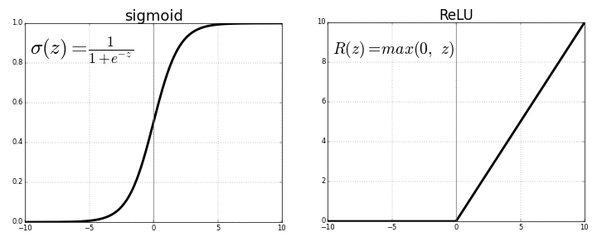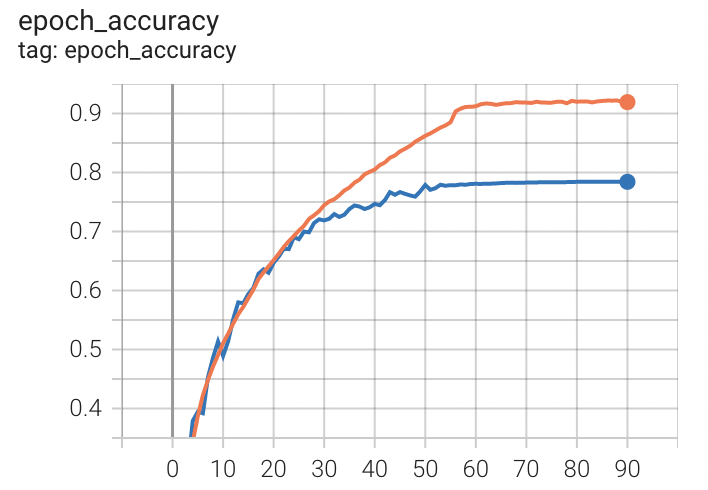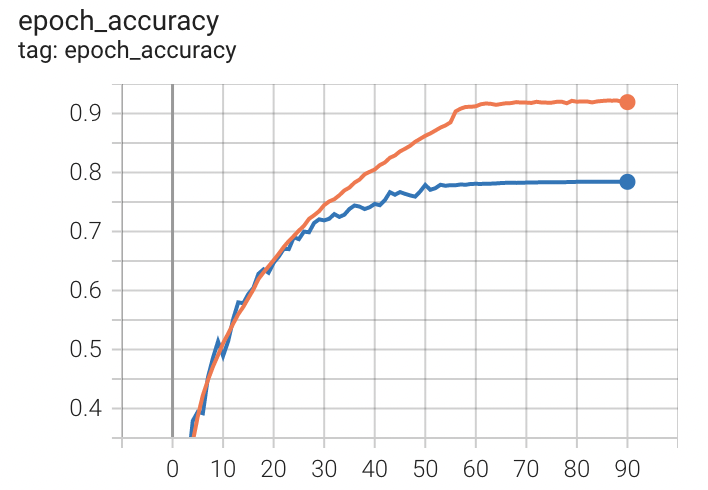*공부 및 복습 용도의 글입니다. 부족하거나 틀린 부분이 있다면 댓글로 알려주신다면 감사드리겠습니다.
- 2022/02/14 수정 - bias initializing에 문제가 있었음.
AlexNet
AlexNet은 Alex Krizhevsky, Ilya Sutskever와 Geoffrey Hinton이 설계한 CNN architecture로, 2012년 ILSVRC에서 큰 격차로 우승하여 이름을 알렸다. AlexNet을 설명한 논문 ImageNet Classification with Deep Convolutional Neural Networks를 살펴보자.
Architecture
ReLU Non-Linearity
- Activation function으로 Sigmoid나 tanh를 주로 사용하던 기존 모델과 달리 AlexNet에서는 ReLU를 사용했다.

- ReLU는 x값이 양수일 경우 기울기가 일정하기 때문에 gradient vanishing 현상이 일어나지 않고, 연산 비용이 비교적 적다. 실제로 CIFAR-10을 가지고 비교한 결과 25% training error rate에 도달하는 시간이 6배 가량 빠르다고 한다.
Training on Multiple GPUs
- 더 큰 네트워크를 위해 2개의 GPU로 병렬 연산을 수행했다. 두 GPU는 3번째 convolutional layer와 FC(Fully connected) layer를 제외하면 독립적으로 훈련을 진행했다.
- GPU를 하나만 썼을 경우와 비교하여, training error를 1~2% 가량 줄였고 시간도 약간 더 빨랐다고 한다.
Local Response Normalization
- ReLU는 sigmoid형 함수와는 달리 input normalization이 필수는 아니다. 하지만 AlexNet에서는 local response normalization를 적용해 오차를 약 1~2% 줄였다고 한다.

- 식이 조금 복잡해 보이지만, 간단히 말해 주변 kernel에 비해 큰 값이 나온 곳을 정규화하는 것이다. i번째 kernel map의 x, y 지점의 값을 (i-n/2)번째~(i+n/2)번째 kernel map의 x, y 지점의 값들을 더해 나누게 된다.
- 최근에는 잘 쓰이지 않는 방법이라고 한다.
Overlapping Pooling
- 전통적으로 pooling은 pooling unit의 크기와 stride의 크기가 같아 마치 격자와 같이 나뉜다. 하지만 AlexNet에서는 pooling unit의 크기가 더 큰 overlapping pooling 기법을 사용해 약 0.4%의 오차 감소를 얻었다.
- 정확한 이유는 나오지 않으나, overlapping pooling을 적용했을 시 과적합 현상이 조금 해소된다고 한다.
Reducing Overfitting
Data Augmentation
- 과적합을 방지하는 가장 쉬운 방법 중 하나는 label-preserving transformation(라벨 보존 변형)을 사용하여 데이터셋을 늘리는 것이다.
- 논문에서는 두 가지 방법의 변형을 사용하는데, 그 중 첫 번째는 반전과 crop이다. 원본 256 X 256의 이미지를 랜덤하게 잘라 224 X 224 이미지를 만들고, 전체를 또다시 반전시킨 버전을 만들면 데이터셋이 2048배로 늘어난다. (* 224 X 224는 논문의 오타이고, stride와 padding을 따져봤을 때 227이 정확한 값이라고 한다.)
- 두 번째 방법은 PCA(주성분분석)를 통해 RGB 값을 변형하는 것이다.
- 논문에 따르면 이러한 data augmentation 없이는 심각한 과적합에 시달린다고 한다.
Dropout
- Dropout은 히든 레이어의 특정 뉴런의 출력을 일정 확률로 0으로 만드는 것을 말한다. 이는 뉴런들의 co-adaption을 줄인다. 즉 불확실성을 부여해 특정 뉴런에 의존하지 못하도록 하는 것이다.
- 이 방법 또한 과적합을 크게 줄여주었다.
Details of Learning
- 찾아보니 loss function은 cross entropy를 사용했다고 한다. Multi-class classification에는 거의 대부분 cross entropy를 사용한다고.
- Weight decay를 사용하였다. weight 파라미터에 크기가 너무 커지지 않게 페널티를 주는 방법으로, 보통 L2 regularization을 많이 사용한다.
- 각 weight는 의 정규분포로 초기화했고, bias는 2, 4, 5번째 convolutional layer와 FC layer들에 한해 1로 초기화했다. 이는 양수값을 줘서 ReLU의 초기 학습을 가속시키기 위해서이다.
- learning rate는 우선 모든 층을 똑같이 맞춘 후, 오차가 더이상 줄지 않을때 10으로 나누는 식으로 조정했다. 초기 learning rate 0.01로 시작해 학습이 끝날 때까지 세 번 나뉘었다.
- 120만 장의 이미지를 약 90번씩 학습시켜 6일이 걸렸다.
Results
- 2010년도 ILSVRC 데이터로 돌려본 결과, top-1과 top-5 부문에서 각각 오차율 37.5%와 17.0%를 기록했다. 당년도 우승 모델은 47.1%, 28.2%였고 이를 크게 뛰어넘은 수치이다.
- 2012년도 ILSVRC에도 참가하여, top-5 부문 오차율을 16.4%까지 줄일 수 있었다.
코드 구현
Papers with Code에 올라온 이 코드와 twinjui님의 코드를 참고하여 작성하였다.
import numpy as np
import pandas as pd
import tensorflow as tf# define model parameters
NUM_EPOCHS = 1000
NUM_CLASSES = 10
IMAGE_SIZE = 227
BATCH_SIZE = 16데이터 전처리. twinjui님의 코드를 사용했다.
from tensorflow.keras.utils import to_categorical
from sklearn.model_selection import train_test_split
from tensorflow.keras.datasets import cifar10
def zero_one_scaler(image):
return image/255.0
def get_preprocessed_ohe(images, labels, pre_func=None):
# preprocessing 함수가 입력되면 이를 이용하여 image array를 scaling 적용.
if pre_func is not None:
images = pre_func(images)
# OHE 적용
oh_labels = to_categorical(labels)
return images, oh_labels
# 학습/검증/테스트 데이터 세트에 전처리 및 OHE 적용한 뒤 반환
def get_train_valid_test_set(train_images, train_labels, test_images, test_labels, valid_size=0.15, random_state=2021):
# 학습 및 테스트 데이터 세트를 0 ~ 1사이값 float32로 변경 및 OHE 적용.
train_images, train_oh_labels = get_preprocessed_ohe(train_images, train_labels)
test_images, test_oh_labels = get_preprocessed_ohe(test_images, test_labels)
# 학습 데이터를 검증 데이터 세트로 다시 분리
tr_images, val_images, tr_oh_labels, val_oh_labels = train_test_split(train_images, train_oh_labels, test_size=valid_size, random_state=random_state)
return (tr_images, tr_oh_labels), (val_images, val_oh_labels), (test_images, test_oh_labels )
# CIFAR10 데이터 재 로딩 및 Scaling/OHE 전처리 적용하여 학습/검증/데이터 세트 생성.
(train_images, train_labels), (test_images, test_labels) = cifar10.load_data()
print(train_images.shape, train_labels.shape, test_images.shape, test_labels.shape)
(train_images, train_labels), (val_images, val_labels), (test_images, test_labels) = \
get_train_valid_test_set(train_images, train_labels, test_images, test_labels, valid_size=0.2, random_state=2021)
print(train_images.shape, train_labels.shape, val_images.shape, val_labels.shape, test_images.shape, test_labels.shape)from tensorflow.keras.utils import Sequence
import cv2
import sklearn
# 입력 인자 images_array labels는 모두 numpy array로 들어옴.
# 인자로 입력되는 images_array는 전체 32x32 image array임.
class CIFAR_Dataset(Sequence):
def __init__(self, images_array, labels, batch_size=BATCH_SIZE, augmentor=None, shuffle=False, pre_func=None):
'''
파라미터 설명
images_array: 원본 32x32 만큼의 image 배열값.
labels: 해당 image의 label들
batch_size: __getitem__(self, index) 호출 시 마다 가져올 데이터 batch 건수
augmentor: albumentations 객체
shuffle: 학습 데이터의 경우 epoch 종료시마다 데이터를 섞을지 여부
'''
# 객체 생성 인자로 들어온 값을 객체 내부 변수로 할당.
# 인자로 입력되는 images_array는 전체 32x32 image array임.
self.images_array = images_array
self.labels = labels
self.batch_size = batch_size
self.augmentor = augmentor
self.pre_func = pre_func
# train data의 경우
self.shuffle = shuffle
if self.shuffle:
# 객체 생성시에 한번 데이터를 섞음.
#self.on_epoch_end()
pass
# Sequence를 상속받은 Dataset은 batch_size 단위로 입력된 데이터를 처리함.
# __len__()은 전체 데이터 건수가 주어졌을 때 batch_size단위로 몇번 데이터를 반환하는지 나타남
def __len__(self):
# batch_size단위로 데이터를 몇번 가져와야하는지 계산하기 위해 전체 데이터 건수를 batch_size로 나누되, 정수로 정확히 나눠지지 않을 경우 1회를 더한다.
return int(np.ceil(len(self.labels) / self.batch_size))
# batch_size 단위로 image_array, label_array 데이터를 가져와서 변환한 뒤 다시 반환함
# 인자로 몇번째 batch 인지를 나타내는 index를 입력하면 해당 순서에 해당하는 batch_size 만큼의 데이타를 가공하여 반환
# batch_size 갯수만큼 변환된 image_array와 label_array 반환.
def __getitem__(self, index):
# index는 몇번째 batch인지를 나타냄.
# batch_size만큼 순차적으로 데이터를 가져오려면 array에서 index*self.batch_size:(index+1)*self.batch_size 만큼의 연속 데이터를 가져오면 됨
# 32x32 image array를 self.batch_size만큼 가져옴.
images_fetch = self.images_array[index*self.batch_size:(index+1)*self.batch_size]
if self.labels is not None:
label_batch = self.labels[index*self.batch_size:(index+1)*self.batch_size]
# 만일 객체 생성 인자로 albumentation으로 만든 augmentor가 주어진다면 아래와 같이 augmentor를 이용하여 image 변환
# albumentations은 개별 image만 변환할 수 있으므로 batch_size만큼 할당된 image_name_batch를 한 건씩 iteration하면서 변환 수행.
# 변환된 image 배열값을 담을 image_batch 선언. image_batch 배열은 float32 로 설정.
image_batch = np.zeros((images_fetch.shape[0], IMAGE_SIZE, IMAGE_SIZE, 3), dtype='float32')
# batch_size에 담긴 건수만큼 iteration 하면서 opencv image load -> image augmentation 변환(augmentor가 not None일 경우)-> image_batch에 담음.
for image_index in range(images_fetch.shape[0]):
#image = cv2.cvtColor(cv2.imread(image_name_batch[image_index]), cv2.COLOR_BGR2RGB)
# 원본 image를 IMAGE_SIZE x IMAGE_SIZE 크기로 변환
image = cv2.resize(images_fetch[image_index], (IMAGE_SIZE, IMAGE_SIZE))
# 만약 augmentor가 주어졌다면 이를 적용.
if self.augmentor is not None:
image = self.augmentor(image=image)['image']
# 만약 scaling 함수가 입력되었다면 이를 적용하여 scaling 수행.
if self.pre_func is not None:
image = self.pre_func(image)
# image_batch에 순차적으로 변환된 image를 담음.
image_batch[image_index] = image
return image_batch, label_batch
# epoch가 한번 수행이 완료 될 때마다 모델의 fit()에서 호출됨.
def on_epoch_end(self):
if(self.shuffle):
#print('epoch end')
# 원본 image배열과 label를 쌍을 맞춰서 섞어준다. scikt learn의 utils.shuffle에서 해당 기능 제공
self.images_array, self.labels = sklearn.utils.shuffle(self.images_array, self.labels)
else:
pass
def zero_one_scaler(image):
return image/255.0
train_ds = CIFAR_Dataset(train_images, train_labels, batch_size=BATCH_SIZE, augmentor=None, shuffle=True, pre_func=zero_one_scaler)
val_ds = CIFAR_Dataset(val_images, val_labels, batch_size=BATCH_SIZE, augmentor=None, shuffle=False, pre_func=zero_one_scaler)가져온 데이터를 시각화해 확인
from matplotlib import pyplot
from keras.datasets import cifar10
# summarize loaded dataset
print('Train: X=%s, y=%s' % (train_ds[0][0][0].shape, train_ds[0][1][0].shape))
print('Test: X=%s, y=%s' % (val_ds[0][0][0].shape, val_ds[0][1][0].shape))
# plot first few images
for i in range(9):
# define subplot
pyplot.subplot(330+1+i)
# plot raw pixel data
pyplot.imshow(train_ds[0][0][i])
# show the figure
pyplot.show()AlexNet 정의.
from tensorflow.keras.layers import *
class AlexNet(tf.keras.Model):
def __init__(self, num_classes=NUM_CLASSES):
super().__init__()
# self.weight = tf.keras.initializers.RandomNormal(mean=0., stddev=1.)
# self.bias = tf.keras.initializers.Constant(1.)
self.lrn = lambda x: tf.nn.local_response_normalization(x, depth_radius=5, alpha=0.0001, beta=0.75, bias=2)
self.regularizer = tf.keras.regularizers.l2(l2=0.0005)
self.net = tf.keras.Sequential([
Conv2D(
filters=96,
kernel_size=11,
strides=4,
# kernel_initializer=self.weight,
kernel_regularizer=self.regularizer
),
ReLU(),
Lambda(self.lrn),
MaxPool2D(pool_size=3, strides=2),
Conv2D(
filters=256,
kernel_size=5,
padding='same',
# kernel_initializer=self.weight,
# bias_initializer=self.bias,
kernel_regularizer=self.regularizer
),
ReLU(),
Lambda(self.lrn),
MaxPool2D(pool_size=3, strides=2),
Conv2D(
filters=384,
kernel_size=3,
padding='same',
# kernel_initializer=self.weight,
# bias_initializer='self.bias',
kernel_regularizer=self.regularizer
),
ReLU(),
Conv2D(
filters=384,
kernel_size=3,
padding='same',
# kernel_initializer=self.weight,
# bias_initializer=self.bias,
kernel_regularizer=self.regularizer
),
ReLU(),
Conv2D(
filters=256,
kernel_size=3,
padding='same',
# kernel_initializer=self.weight,
# bias_initializer=self.bias,
kernel_regularizer=self.regularizer
),
ReLU(),
MaxPool2D(pool_size=3, strides=2),
Reshape((-1, 256 * 6 * 6)),
Dropout(0.5),
Dense(4096),
ReLU(),
Dropout(0.5),
Dense(4096),
ReLU(),
Dense(num_classes, activation='softmax'),
])
def call(self, inputs):
return tf.reshape(self.net(inputs), (-1, 10))from tensorflow.keras.callbacks import ReduceLROnPlateau, EarlyStopping
rlr_cb = ReduceLROnPlateau(monitor='val_loss', factor=0.001, patience=5, mode='min', verbose=1)
ely_cb = EarlyStopping(monitor='val_loss', patience=15, mode='min', verbose=1)
tb_path = './tensorboard'
tensorboard_cb = tf.keras.callbacks.TensorBoard(log_dir=tb_path)
alexnet = AlexNet(num_classes=NUM_CLASSES)# alexnet = tf.keras.models.load_model("alexnet")alexnet.compile(
optimizer=tf.keras.optimizers.SGD(0.0001, momentum=0.9),
# optimizer=tf.keras.optimizers.Adam(0.0001),
loss=tf.keras.losses.CategoricalCrossentropy(),
metrics=['accuracy'],
run_eagerly=True
)
alexnet.fit(train_ds, verbose=1, validation_data=val_ds, epochs=NUM_EPOCHS, callbacks=[tensorboard_cb, rlr_cb, ely_cb])
test_ds = CIFAR_Dataset(test_images, test_labels, batch_size=BATCH_SIZE, augmentor=None, shuffle=False, pre_func=zero_one_scaler)
alexnet.evaluate(test_ds)alexnet.save("alexnet")결과
-
더이상 validation loss가 줄지 않을 때까지 돌려 91 epoch 동안 진행했다. 약 10시간이 소요됐다.
-
train loss는 0.7150, train accuracy는 0.9193으로 마무리 지었고, 최종 validation loss는 1.1215, validation accuracy는 0.7842였다.
-
이후 test dataset에 대해 평가한 결과 loss는 1.1369, accuracy는 0.7797이었다.
주황색이 train accuracy, 파란색이 validation accuracy이다.

-
코드 구현에 시행착오가 좀 있었다. Weight initialization에서, 처음에는 논문에 나온 그대로 mean=0, stddev=0.01인 random normal로 초기화했다. 그러나 아무리 기다려도, 몇번을 시도해도 loss가 일정 수준 이상으로 낮아지지 않았다. 물론 accuracy도 높아지지 않았다.
-
결국 weight initializer를 따로 설정하지 않고 학습을 시작하자 금방 원하는 결과가 나왔다.(위의 결과) Conv layer에 initializer를 설정하는 것 자체가 문제가 되는 모양인데, 원인을 좀 더 찾아봐야할 것 같다.
weight initializer는 상관이 없었다! 문제는 bias initializer였다. 그런데 여전히 알 수 없는 점은 왜 그런지이다. Bias를 두 개 이상 1로 설정하면 문제가 생기고, 그 중 하나를 약 0.8 미만으로 바꾸면 전혀 문제가 없다. 역시나 추가적인 고민이 필요하다. -
optimizer 또한 논문처럼 SGD(momentum=0.9)를 사용했다. 이후 Adam optimizer를 사용해 다시 돌려봤는데, 약 4배 이상 빠르게 학습을 완료했다. 아무래도 웬만한 상황에선 Adam이 좋은 듯하다... 애초에 Adam은 AlexNet 논문의 시점으로부터 꽤 지난 2014년에 나왔으니 말이다.
요약 및 논의
- ReLU nonlinearity를 사용해 gradient vanishing 현상을 해결하고 시간을 줄일 수 있었다.
- Dropout과 data augmentation으로 과적합을 크게 줄였다.
- Local Response Normalization을 사용.
- ReLU는 적당한 양수값으로 초기화하는 게 좋다.
- 제대로 파라미터를 초기화하지 못했다. 원인을 파악해야할 듯.
- 약간의 과적합이 있다. 추후 data augmentation도 시도해봐야겠다.
참고자료
https://wikidocs.net/64066 (CNN)
https://taeguu.tistory.com/29 (local response normalization)
https://stats.stackexchange.com/questions/432896/what-is-the-loss-function-used-for-cnn (cross entropy)
https://89douner.tistory.com/60
https://github.com/dansuh17/alexnet-pytorch, https://velog.io/@twinjuy/AlexNet-%EB%85%BC%EB%AC%B8-%EB%A6%AC%EB%B7%B0-with-tensorflow (코드 구현)
